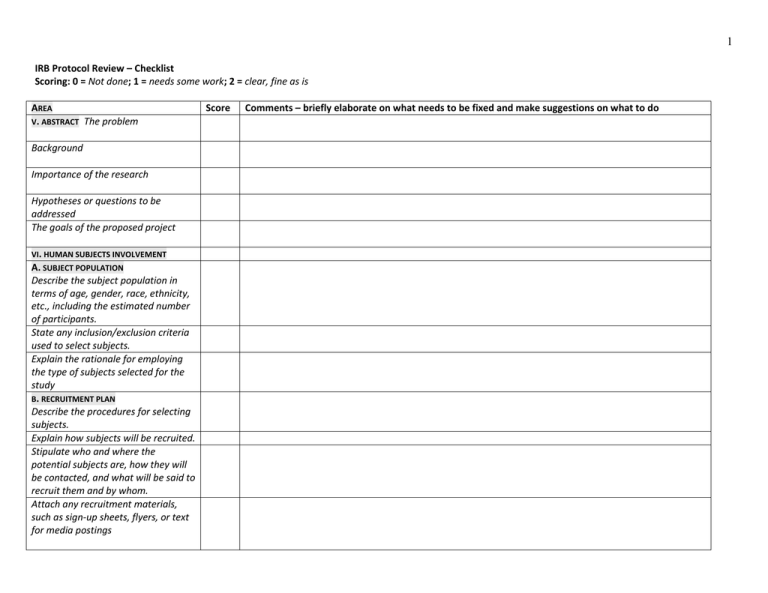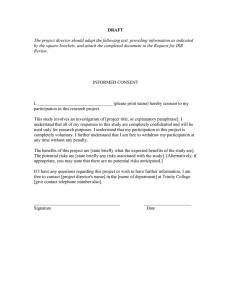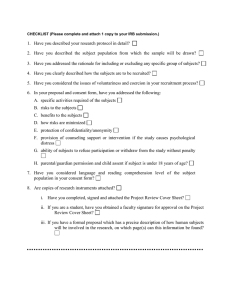1
advertisement

1 IRB Protocol Review – Checklist Scoring: 0 = Not done; 1 = needs some work; 2 = clear, fine as is AREA V. ABSTRACT The problem Background Importance of the research Hypotheses or questions to be addressed The goals of the proposed project VI. HUMAN SUBJECTS INVOLVEMENT A. SUBJECT POPULATION Describe the subject population in terms of age, gender, race, ethnicity, etc., including the estimated number of participants. State any inclusion/exclusion criteria used to select subjects. Explain the rationale for employing the type of subjects selected for the study B. RECRUITMENT PLAN Describe the procedures for selecting subjects. Explain how subjects will be recruited. Stipulate who and where the potential subjects are, how they will be contacted, and what will be said to recruit them and by whom. Attach any recruitment materials, such as sign-up sheets, flyers, or text for media postings Score Comments – briefly elaborate on what needs to be fixed and make suggestions on what to do 2 AREA C. RESEARCH METHODS AND DESIGN / PROCEDURES Include a description of the project design and procedures. Describe what the subjects will do, step by step, and the duration of the study. State where, when, and by whom the research will be conducted. If treatment is to be done, state the qualifications of the practitioner. D. MATERIALS AND DEVICES a. List the kinds of instruments that will be used (e.g., surveys, questionnaires, interview questions, data intake sheets) & attach copies. If translated, submit English and translated version of the data instruments, AND the Verification of Translation Accuracy Form. b. Describe any cognitive or psychological tests that will be employed & provide examples of any computer stimulus/test materials. c. Describe how the investigator will record information, whether audio/video recording devices will be used. If participants will be recorded or photographed, describe how these materials will be used, including whether or not they will be presented in publication or dissemination. E. CONFIDENTIALITY Indicate whether or not any identifying information will be collected and/or reported. Score Comments – briefly elaborate on what needs to be fixed and make suggestions on what to do 3 AREA Score E. CONFIDENTIALITY Describe reporting methods. If identifying information will be collected but not reported, describe mechanisms for maintaining confidentiality (e.g., pseudonyms, coding system). If subjects are to be identified with the data, indicate the extent to which the subject’s name or other identifiers will be used. b. Specify how data/materials collected will be kept safe and who will have access to the data/materials. F. COMPENSATION State any compensation that will be awarded to subjects for participation in the study (e.g., cash payment, gift card, course credit, free treatment). G. POTENTIAL BENEFITS List any potential direct benefits such as health-related or psychosocial benefits to an individual subject. List any indirect benefits e.g. how the research may contribute to the acquisition of generalizable knowledge. H. POTENTIAL RISKS Describe any potential risks - whether physical, psychological, social, legal, or other - and assess their likelihood and seriousness. Examples of risks include: physical injury, allergies to the materials used in the study, loss of privacy, the release of potentially Comments – briefly elaborate on what needs to be fixed and make suggestions on what to do 4 AREA damaging personal information, psychological trauma, and emotional discomfort (e.g., anxiety, stress, depression). I. RISK REDUCTION Describe the procedures for protecting against or minimizing each potential risk listed above. E.g, risk of loss of privacy may be reduced by storing all research material in a locked cabinet, by using codes rather than participant names on surveys, or by conducting an anonymous study. Describe special safety procedures, as needed, to avoid harm to subjects. List any psychological and/or medical help available in the event of harm. For example, if the risk of emotional discomfort is high, the investigator should provide the subjects with a list of referrals for counseling and attach this information to the informed consent document. A. CONSENT PROCESS [Describe procedures for obtaining informed consent from subjects, including procedures for obtaining assent from minors. Indicate who will obtain consent/assent, what language will be used, where and when consent/assent will be obtained, and what steps will be taken to minimize the possibility of coercion or undue influence. Score Comments – briefly elaborate on what needs to be fixed and make suggestions on what to do 5 AREA Score B. SPECIAL CONSENT PROVISIONS If some subjects will be cognitively impaired, visually impaired, physically impaired, or have language/hearing difficulties describe how capacity for consent will be determined. If you need to obtain informed consent from legally authorized representatives, describe how you will identify an appropriate representative and ensure that their consent is obtained. C. WAIVER OF WRITTEN CONSENT If requesting a waiver for obtaining written consent from participants, provide a justification for the request and include a description of alternative procedures for obtaining informed consent. D. DEBRIEFING [If the study involves deception, describe the debriefing procedures that will be enacted and attach any informational materials that will be given to subjects E. CONSENT FORMS [Attach the appropriate consent form, letter, or script that will be used. CONSENT FORM: Follow the format and instructions provided with these templates whenever possible. VIII. OTHER [If there are issues which the board should consider which do not fall into any category above, please describe them here. Comments – briefly elaborate on what needs to be fixed and make suggestions on what to do


